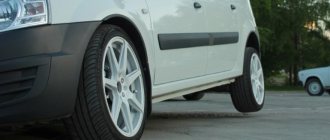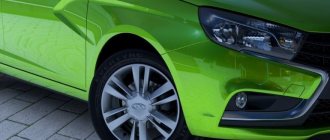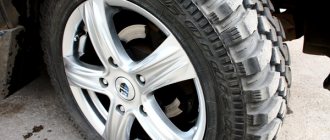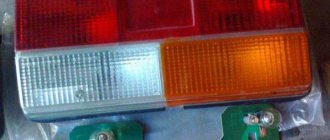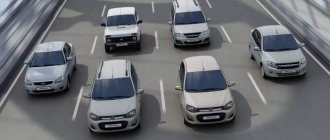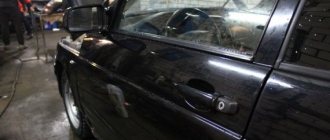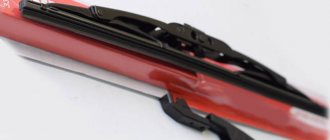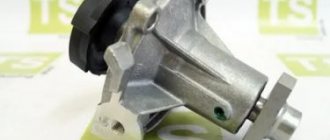Winter time requires motorists to prepare their cars for difficult weather conditions. A misconception is that in winter you can use all-season or summer tires. This type is technologically not intended for use in winter.
Many people believe that winter tires on a VAZ differ from summer tires only in the tread pattern. This is partly true, but the main difference lies not in the tread, but in the type of rubber itself. At low temperatures, rubber becomes hard and the quality of grip on the road surface decreases. The composition of winter tires is selected so that the material does not lose softness even in severe frost. This feature can explain why it is not recommended to use winter tires in summer; at positive temperatures, soft rubber will become even softer, which will complicate driving.
Often, owners consider it sufficient to install winter tires only on the drive axle, but this idea does not meet safety requirements, since the risk of skidding increases, traction forces are not balanced and there is a danger of maintaining straight-line motion when turning.
What non-standard sizes can be supplied?
Some vehicle owners practice installing wheels whose diameter differs from the standard one.
It is important to remember that increasing the diameter, width of the wheel, or tread height can cause serious problems.
For example, mounting 16" wheels on vehicles whose arches are designed for 14" tires may cause:
After installation, non-standard wheels should not touch body elements or wheel arch liners. This will not only damage the plastic and paint. But it can cause other problems. Constant friction of the tire against the fender liner leads to rapid wear of the tread. Which requires premature tire replacement.
The difference in weight between tires with a standard diameter and those that are just 1-2 inches larger can be several kilograms. Such a difference in weight suggests accelerated wear of wheel bearings and other body elements. First of all, suspension components. Increased load accelerates the failure of racks and other components.
When choosing custom tires, keep the following points in mind:
To install wheels of larger diameter, in some cases it will be necessary to roll out the wheel arches with a special roller. It will allow the openings to be enlarged, and the new wheel will no longer wear off the tread on the plastic of the fender liner.
Standard tires
The original wheels also go with the original tires. Their standard designation is 175/70 R13 82T. Let's go through the decoding again:
- 175 is the width of the tire profile in mm;
- 70 – percentage ratio of tire width and profile height;
- R – rubber type, radial;
- 13 – tire radius in inches (select for the rim);
- 82 – maximum tire load, in this case it is 470 kg;
- T – maximum possible speed, equal to 190 km/h.
The manufacturer also recommends a 165 mm wide tire. The wheel size is 80R13. The load indicators are the same. This rubber is low-profile, single-layer steel cord breaker.
Tires should be selected according to the following criteria:
- Low-profile tires have a beneficial effect on vehicle handling, but in the event of impacts, the risk of damage to the chassis increases significantly.
- A profile that is too large, on the contrary, may not fit into the arch, which is why it will constantly wear out;
- Also, a non-standard profile height will affect the speedometer readings, because the length of the rim changes.
- When selecting large rims and tires, it is very important to maintain the correct bolt pattern and fit it all into the wheel arches accurately;
- If the tire has a low load, it may burst when hitting an obstacle if the vehicle is fully loaded.
Like any other car, the 7 is equipped with summer, winter and all-season tires. All-season tires, in principle, show good results, but they are inferior to summer and winter tires when compared under the conditions of their “native path”.
Therefore, it is recommended for any car owner to have 2 sets of tires for the cold and hot seasons of the year.
Characteristics of winter tires for VAZ 2107
A winter tire is distinguished by the fact that it is made of softer rubber, which does not allow it to harden in the cold. It has a higher tread.
The design includes many small wavy lamellas, which open when in contact with asphalt, as if sticking to the road surface.
This structure allows you to move well on compacted and even icy roads. Due to the shape of the tread and its size, the tire can paddle well on loose snow.
Such tires are divided into “Velcro” and studded.
Studded winter tires
The principle of operation of the former is reminiscent of suction cups, which we described earlier, but the studs help to better cope with acceleration and braking on icy and compacted roads. Metal spikes “bite” into the hard surface, which ensures better contact with it.
Traditionally, studded tires are considered a more reliable solution for driving on snowy roads. This is confirmed by many test drives that are conducted annually by various companies and auto magazines.
However, such rubber also has its disadvantages:
Firstly, not all regions of our country have snow on the roads all winter, especially in the south, where snowfalls occur once or twice a month and most of the time you have to drive on cold asphalt. In braking on such a surface, Velcro will definitely be better.
Secondly, if you ride on spikes on “bare” asphalt, you will constantly hear an annoying noise.
Thirdly, almost all imported rubber is studded at Russian enterprises - only blanks are supplied. For this reason, the studs are often poorly installed and constantly fall out.
And if the loss of a few pieces is not critical, then when the amount approaches 5-7 percent, the effectiveness of such a tire decreases many times over. Again, this is facilitated by driving on such tires on asphalt.
Velcro (friction)
“Velcro” also shows good results in terms of acceleration and braking on different roads. At the same time, it is not so noisy - even in the northern regions of our country, many drivers prefer just such tires.
Winter tires are indicated by the manufacturer either with a painted snowflake or with the M+S marking (Mud+Snow/Mud+Snow). They will also be easy to recognize by their tread type and increased softness.
Summer tires are stiffer, which is explained by the smaller amount of natural rubber in the composition. This tire wears out much more slowly and performs very well at high temperatures, when winter tires would become too soft to handle serious loads.
Protectors are divided into several types - they are symmetrical and asymmetrical, while within each type you can find a directional pattern and a non-directional one.
If the tire tread is directional, then on the side it will indicate the Rotation value and an arrow indicating the correct direction of rotation.
About tire sizes for a VAZ 2110 car
Reading time: 5 minutes
Choosing the right wheel size for the VAZ-2110 is not difficult. The factory parameters correspond to only two sizes: 13 and 14 inches, so there should be no problems with the choice. The car was produced in sedan, hatchback and station wagon bodies and was equipped with both cast light-alloy products and steel ones produced by stamping.
This model of the domestic concern VAZ has become very widespread and popular. In this regard, choosing wheels for it will not be a problem due to the fact that a large number of manufacturers, mainly domestic, produce wheels specifically for the concern’s model range.
Wheels for VAZ 2110
Review of the best summer and winter tires for the VAZ 2110
Every driver understands that the wheel plays a very important role not only in comfort and design, but also significantly affects driving safety. For this choice, the tire needs to be given enough attention. In addition to the basic or acceptable standard size, you should not forget about:
- speed limit in which the car will be operated (speed index);
- temperature regime (seasonality);
- climatic conditions (tread pattern and depth);
- weight load on wheels (load index).
If you choose tires by manufacturer, then from the many domestic ones you can choose several that have significantly increased the quality of their products compared to previous years. These can deservedly be called: Amtel, Matador-Omskshina, Kama.
- Amtel tires in Russia are undoubtedly the leaders (among domestic ones). Produced in Voronezh. In the process of testing this product, it was proven that it is no worse than foreign ones. The plant makes tires of all categories. The company has excellent specialists at its disposal who are constantly improving the production process.
- Matador-Omskshina is one of the youngest manufacturers, but sales volume is growing significantly every year. Drivers who prefer models from this manufacturer note reliability, stable performance and comparative cheapness.
- Kama (Nizhnekamsk) – produces tires for Russian buyers of all classes. But for cars of the 2110 model, the assortment is rather meager.
Specifics of winter tires for VAZ 2107
Regardless of the engine modification, the wheel size is R13, only tire size 175/70 is suitable for such wheels. Of course, it is possible to switch from R13 to R14 tires, but there are few benefits in such a replacement, the car’s handling will improve slightly, and the possibility of disc deformation will increase significantly. The tire size for VAZ 2107 and 2106 is identical.
So which winter tires are better for the VAZ 2107, Velcro or studded? When asking this question, you need to remember that the car is rear-wheel drive, for this reason it is prone to slipping during the start and skidding when entering a turn. Considering these criteria, the best choice would be winter tires with studs.
On rear-wheel drive cars, it is necessary to install more worn tires on the rear axle. Tests have confirmed that such a replacement is safer for maintaining dynamics.
If a tenon is lost, replacing the element with a new one is not practiced, since it is impossible to securely fasten the element in the old hole.
Winter tire
When choosing winter tires for a VAZ 2110, the contents of the driver’s wallet play an important role. After all, products on this market are represented by both domestic and imported manufacturers. But if rubber is expensive, this does not mean that it will be more efficient. It’s just that many imported manufacturers do not take into account the difference in climatic conditions and the concept of “winter” can be radically different. As a result, expensive tires in our regions can give poor results.
It is difficult to say about the advantages of certain winter tires - each person has his own opinion on this matter. Some prefer Nokan Hakkapeliitta (according to many, it is one of the best), while for others, the domestic Amtel is quite acceptable (the cost is of course lower, but the characteristics are quite acceptable).
The middle option would be models from manufacturers Hankook, Continental and Bridgestone, although domestic ones are still more profitable in terms of cost.
For example, Nokian Nordman RS2 185/65 R14 90R XL can be bought for 3700 – 4200 rubles. This winter tire has a low noise level and a long service life. Equipped with a tread wear indicator. The wedge-shaped laminated design ensures a stable ride. The degree of grip during braking is enhanced by the serrated sipes. Has a reinforced sidewall.
Amtel NordMaster ST-310 185/65 R14 86Q is a domestic tire that, according to car enthusiasts, deserves a solid 4. It runs well, the tread is deep. On snow it’s ok, but on ice it’s weak. The obvious disadvantage is increased noise. You can buy up to 1500 rubles. a piece.
